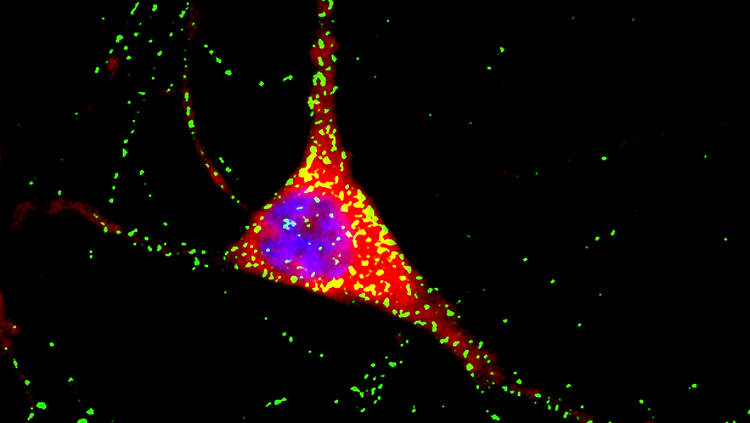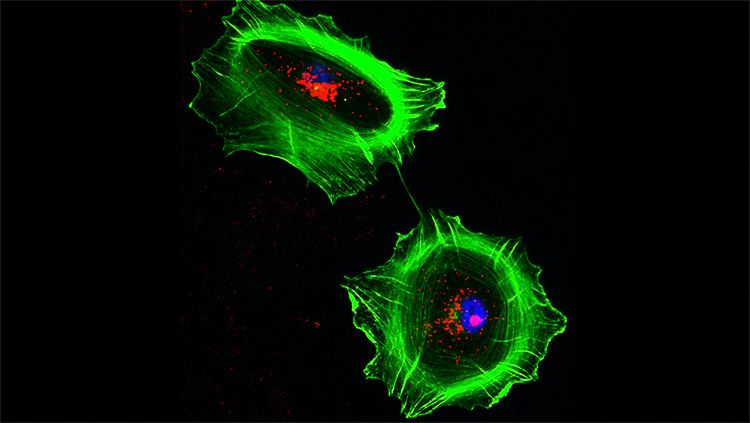Chapter XI: Nurturing a Global Society
"We are committed to the principle that SfN should be useful to its members wherever they live and work." -- Eve Marder, 2008463
SfN at the beginning was largely an American story, reflecting that region’s dominance in the field, though the leadership envisioned a global society that spoke for all of neuroscience, not just for the parochial interests of neuroscientists in a single country. Major international membership contingents represented the U.K., Canada, Germany and Japan. Even before 2000, Neuroscience Newsletter and Neuroscience Quarterly consistently reported on the activities of the Canadians Association for Neuroscience, included articles by the presidents of FENS and IBRO, and highlighted how international chapters were celebrating Brain Awareness Week.464 BrainFacts.org was an international resource for reliable facts about the nervous system from its inception, with more than half of the visitors to the site coming from outside the United States.465 Neuroscience Quarterly consistently featured the winners of the International Brain Bee, many of whom attended the Annual Meeting.466
In the post-WWII era, North American institutions, laboratories and scientists had driven the development of neuroscience. For example, between 1999 and 2003, U.S. authors contributed 26% of the global output of scientific articles, and the U.S.’ share of global research and development expenditures was around 40%. But the 21st century saw these figures begin to shift. But by 2011, the U.S.’s share of global research and development expenditures had declined to 30%, while U.S. authors contributed 21% of the scientific literature published in the 2010s. SfN membership reflected these changes and supporting the global community of neuroscientists was a pillar of every version of SfN’s strategic plan from 2002, when the percentage of members from outside the United States had reached 31%.467 The leadership already fully recognized the Society as an international organization with a role in members’ lives across the globe. This commitment only grew stronger as international membership continued to rise, levelling off at 35% by 2020,468 including 3,000 international members from more than 90 countries, 60% of them regular members. The most recent growth in membership came from Mexico, China, South Korea, and India. Yet international scientists also found themselves facing travel and financial restrictions that hampered them from presenting and publishing their work.
As Steve Hyman, SfN President 2014–15, commented, “[T]he global politics is tending toward fragmentation and nationalism and I think science is a critical glue that will help hold people together.”469
Embracing SfN's International Identity
The International Affairs Committee (IAC), initially established in 2000 as a joint endeavor with the National Academies of Science to act as representatives of North American neuroscience to IBRO, quickly became a key liaison for SfN’s international scientific educational programs, fellowships, and the equipment exchange program.470 With a broad and flexible mandate, IAC claimed a place in both the Membership and Professional Development Clusters as part of the committee reorganization in 2005. The IAC established its independence from IBRO and the National Academies in 2010, as a collaborator focusing on joint educational and advocacy programs on behalf of SfN.471 As all of SFN’s committees began to focus on international members and on global member value, in 2014, the Membership and Chapters Committee and the International Affairs Committee “merged into a single Global Membership Committee.”472
One key transition to a more global SfN was the elimination of the distinction between North American and ‘foreign’ members in the by-laws in 2003.473 As SfN President (2004–5) Carol Barnes noted, “if you’re a member, you’re a member, you’re a regular member,” and all members paid the same fees and enjoyed the same benefits.474 Over the next 10 years, international members became eligible to serve on all committees, as well as on Council and the Executive Committee.475 While a number of past Presidents had been born outside the United States, 2019 marked the first election of a President from an institution outside North America, Barry Everitt of Cambridge University.
The change in membership status for international members had a dramatic effect. Between 2001 and 2007, “regular international membership grew by 39% and international student membership outside North America grew by a considerable 117%.”476 By the fall of 2010, Council noted that the “fastest growing sectors of the membership are students and those residing outside of the U.S.”477 IAC conducted an international member survey in October 2010 to “identify ways SfN might better serve their professional and career development needs,” later collaborating with the Trainee Advisory Committee on surveys of the entire SfN membership in 2011 and 2016.478

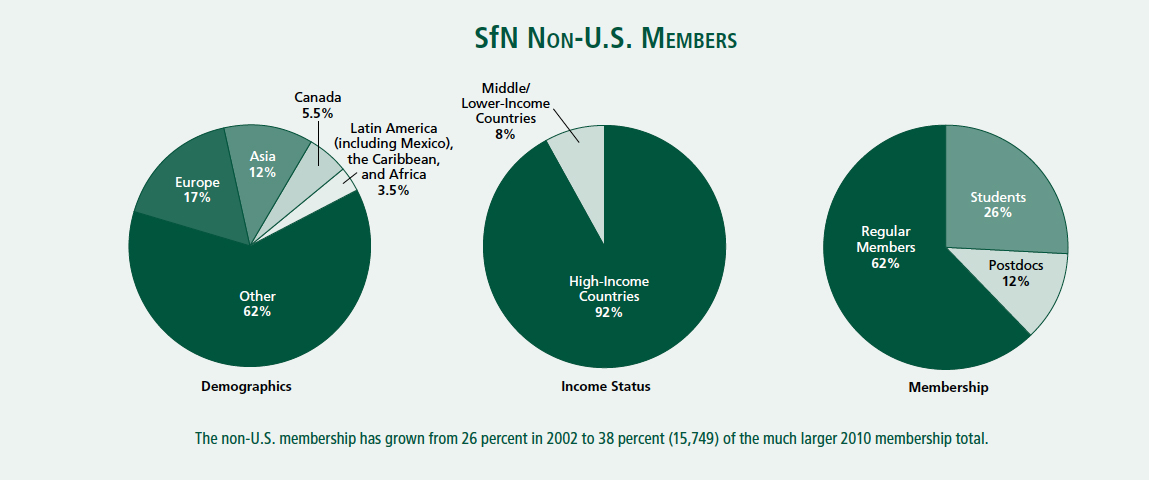
Leading the Global Scientific Community
While all SfN members faced challenges in accessing funding for research and conferences, publishing their research, and finding job opportunities, non-U.S. members described “several additional challenges, including lack of access to professional networks for research and scientific exchange and lack of necessary research infrastructure/technologies.”479 The Member Enhancement Plan Working Group addressed these concerns directly in 2012, suggesting that Council increase funding for international members to attend the Annual Meeting and provide year-round resources for training and publishing.480 SfN leadership also entered into strategic partnerships with its international partners to provide advice and coordinate advocacy programs for science around the world.481
Canada was the first beneficiary of such a partnership in the late 1990s and 2000s. The NeuroScience Canada Partnership and Foundation, founded in 1998, provided the initial channel for advocacy support. In 2004, Council approved the translation of the SfN Guide to Public Advocacy into French and agreed to contribute funding to the Canadian Association for Neuroscience (CAN) to support a lobbyist in Ottawa and related activities.482 “We needed help just [for] guidance of how effective it is. We needed to do it in [the] context … [of ] the Canadian government system,” CAN leader and SfN Councilor Brian MacVicar explained.483 NeuroScience Canada published The Case for Canada’s Increased Investment in Neuroscience Research in 2006 and, in 2011, now renamed BrainCanada, successfully advocated for a dedicated fund for Canadian brain research.484 In 2018, after several lean years, the hard work of CAN and BrainCanada paid off in an “historic” $3 billion government commitment to research, including a 25% increase in basic science funding and more than $1.7 billion over 5 years to support individual researchers. After the first twelve years of a strong partnership, SfN and CAN signed a memorandum of understanding (MOU) agreeing to three more years of joint support for “advocacy targeting four groups in Canada: neuroscientists, government, media, and the public”.485
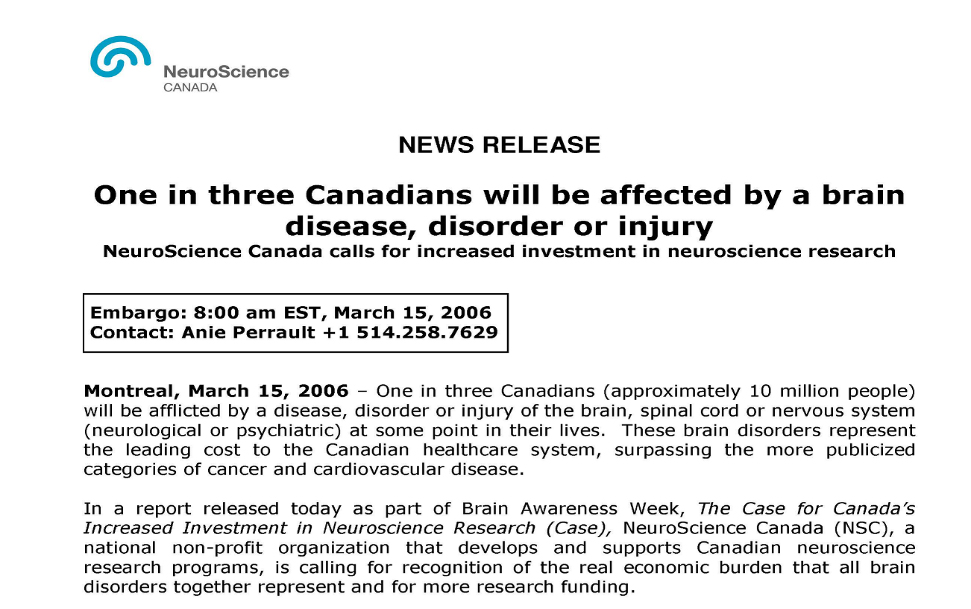
The Society began its science advocacy collaboration with the Federation of European Neuroscience Societies (FENS) in 2011. Fifty scientists from 29 national societies attended a workshop in Brussels in June, where SfN members presented advocacy strategies, tools and resources, and FENS members gave talks on their experiences and achievements. SfN and FENS then pooled resources to create an Advocacy Grants Program, offering grants to the national groups for projects in “legislative strategy, member involvement, resource creation and adaptation, and strategic partnerships,” developed to fit each nation’s particular political and cultural situation. The first 10 Advocacy Grants, announced in December, went to projects in Croatia, France, Greece, Hungary, Ireland, Italy, Portugal, Slovenia, Spain, and the UK.486 As GPA Chair Anne Young commented, “We know national and regional neuroscience societies are uniquely positioned to lead advocacy programs that reflect each country’s funding and political systems.”487 By 2015, SfN and FENS had partnered with IBRO in the Global Advocacy Initiative, to encourage societies in all countries to promote science with their legislators and elected officials.488 IBRO President Pierre Magistretti observed, “Europe is a bit more complicated because we have many nations, not just one nation.... It’s not exactly the same kind of context. Yet the message is always the same…promote neuroscience, promote support for neuroscience.”489
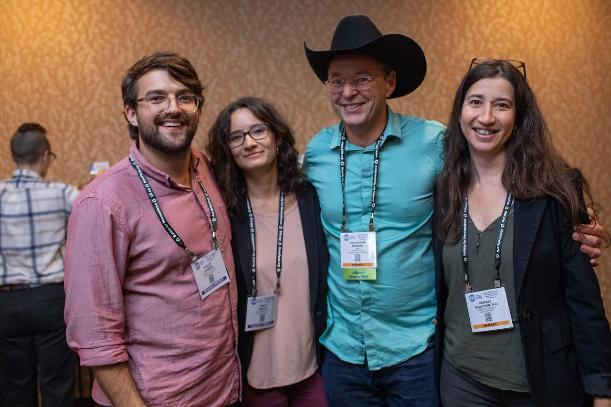
Many critical issues, such as ethics and responsible scientific conduct, required SfN to coordinate with as many global partners as possible. In 2011, SfN, as part of its ongoing effort to promote responsible scientific communication, joined IBRO, FENS, the Japan Neuroscience Society, and the Chinese Neuroscience Society to run three educational programs on ethics, including a panel discussion at the IBRO meeting, a workshop at Peking University and another panel at the Chinese Neuroscience Society meeting.490 SfN’s advocacy leadership, as Magistretti recalled, “actually triggered the establishment of a global advocacy initiative... where IBRO is playing a key role as kind of an umbrella organization.”491
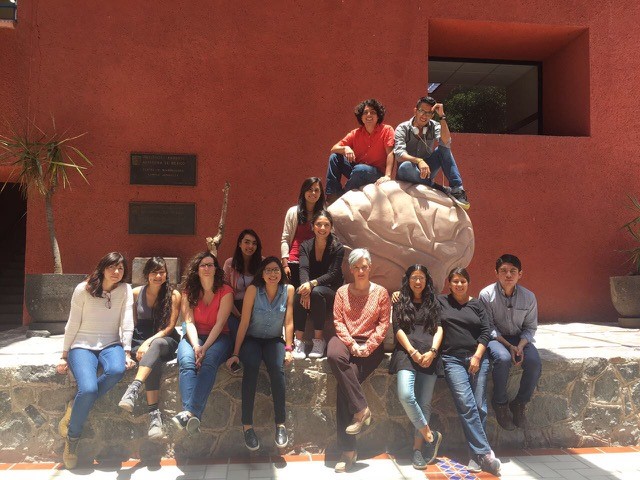
Supporting Neuroscience Students Around the World
SfN initiated a number of programs in the 2010s specifically for graduate students and early career researchers from outside the United States, in Latin America, Europe, and Asia. The four-week Ricardo Miledi Neuroscience Training Program in Mexico, generously funded by the Grass Foundation from 2004–12, evolved into the Latin American Training Program in 2014.492 The first joint Programme of European Neuroscience Schools (PENS)-SfN was held in Naples in 2010. In 2012, SfN established an exchange program with the Japanese Neuroscience Society, providing shared funding for trainee members of each group to attend the other’s meeting.493 SfN also supported local and regional chapter educational initiatives such as the biannual summer course run by the Turkey Chapter that attracted students from across the Middle East.494
From 2014, SfN leadership reinforced the identification of SfN as a global organization, from combining the IAC and Membership Committees into the Global Membership Committee in 2014 to committing to supporting neuroscientists in developing regions of the world.495
After the 2016 election, many international scientists were concerned about the effect of the new administration’s policies on their ability to present their research at SfN; abstract submissions decreased by 8% the following year. SfN leadership and staff worked hard “to reassure our membership of thirty-six thousand people, from eighty different countries around the world, that SfN stood for an international investment in neuroscience;”496 as SfN President Eric Nestler stated in his Spring 2017 “Affirmative Attention” message, “scientific innovation has always been an international effort.” SfN remained committed to global cooperation and science without borders in the face of increasing nationalism around the world and tougher visa restrictions in the United States. For the first time at the 2019 Annual Meeting, scientists denied a visa to come to the United States were enabled to present their work at a poster, symposium, or nanosymposium, with the aid of volunteers through the Science Knows No Borders program.497 In September 2019, SfN was a signatory to an AAAS letter to U.S. governmental science agency heads urging them to support measures that “ensure that the U.S remains a desirable and welcoming destination” for researchers from around the world.498
Related
Endnotes
- Eve Marder, “Message from the President: Seeking Synergy Between Local and Global Scientific Cultures,” NQ Winter 2008: 1–3, p. 3.
- See “BAW 1999: An International Campaign,” NN 30 (May/June 1999): 6, for example.
- “BrainFacts.org Celebrates Its First Anniversary,” NQ Summer 2013: 12; “Educating and Engaging The Public,” Creating Value in Challenging Times: FY2013 Annual Report, p. 13; “Educating and Engaging the Public,” Investing in Global Connections for Scientific Progress FY2018 Annual Report.
- https://thebrainbee.org/about/#history
- "New Diplomatic Efforts Support a Growing International Membership” NQ Fall 2010: 1, 8
- “A Global Perspective: SfN Surveys Non-U.S. Members,” NQ Spring 2011:10–11, p.10; international membership peaked at 38% in 2010. More recent figures courtesy of SfN Operations.
- Interview with Steve Hyman, November 4, 2018.
- "Joint Committee to Represent SFN and National Academy on International Affairs,” NN 31 (July/August 2000):1, 17; “International Affairs Committee Launches Equipment Exchange and other Initiatives,” NN 32 (September/October 2001):23.
- SfN Fall Council Minutes, November 17, 2010, p. 7.
- “ Message from the President: International Collaborations Can Strengthen Neuroscience,” NQ Winter 2005:1–3; “New Strategic Plan,” p.4; “Council Roundup Summer Meeting” NQ Fall 2014:1, 9.
- “ Society Membership Growth Invigorated by New Measures” NQ Summer 2003:9.
- Interview with Carol Barnes, November 5, 2018.
- “Fall 2008 Council Roundup,” NQ Winter 2009:3; “A Global Perspective: SfN Surveys Non-US Members,” NQ Spring 2011: 10–11; “Council Roundup: Spring 2014 Meeting,” NQ Summer 2014:13.
- "Society Explores Changing Membership” NQ Winter 2008: 4.
- “Council Roundup,” NQ Fall 2010: 1, 14–15.
- “A Global Perspective: SfN Surveys Non-US Members,” NQ Spring 2011:10–11; “Exploring the Changing Needs of SfN Members” NQ Fall 2016.
- “A Global Perspective: SfN Surveys Non-US Members,” NQ Spring 2011:10–11
- “Council Roundup” NQ Summer 2012: 12; “Council Roundup: Summer 2014 Meeting,” NQ Fall 2014:1, 9.
- Interview with Brian MacVicar, November 5, 2018; “Message from the President: Seeking Synergy Between Local and Global Scientific Cultures,” NQ Winter 2008:1–3; “Message from the President: Serving Members Worldwide, Forging Global Partnerships,” NQ Fall 2011:1–2, “Message from the President: The Importance of Global Advocacy
and Communication to Ensure the Long-Term Strength of Neuroscience,” NQ Spring 2013:2–3; “European Advocacy Grants Program Announces First Recipients,” NQ Winter 2012:1,8; “Global Collaboration Bolsters Support for Research,” NQ Summer 2017. - “Message from the President: International Collaborations,” p. 3.
- Interview with Brian MacVicar, November 5, 2018.
- "Q&A: Brain Canada and Canadian Neuroscience Funding,” NQ Spring 2016.
- "Advocacy Investment Achieves Billions for Canadian Research and Development,” NQ Summer 2018.
- “European Advocacy Grants,” p. 8.
- "FENS and SfN Announce 2013 Advocacy Grant Recipients,” NQ Winter 2013:1, 9, p. 9.
- “Message from the President: Becoming a Science Advocate,” p.2.
- Interview with Pierre Magistretti, November 6, 2018.
- Susan Amara, “Serving Members Worldwide, Forging Global Partnerships,” NQ Fall 2011:1–2; “SfN’s Global Collaboration on Responsible Scientific Communication,” NQ Fall 2011: 8, 14–15.
- Interview with Brian MacVicar, November 5, 2018; Interview with Magda Giordano, November 7, 2018; Interview with Pierre Magistretti, November 6, 2018.
- "First Class Completes Miledi Training Course,” NQ Spring 2005:13; http://www.sfn.org/Initiatives/Diversity-Programs/Latin-American-Training-Program
- “New International Partnership Expands European Training Program” NQ Fall 2009:6; “International Exchange Program Benefits Japanese, North American Trainees” NQ Winter 2014:12.
- Interview with Reha Erzurumulu, November 4, 2018.
- “Council Roundup: Summer 2014 Meeting” “Summer Council Roundup” NQ Fall 2015.
- Interview with Eric Nestler, November 3, 2018.
- Neuroscience 2019: A Melting Pot for New Scientific Discoveries” NQ Spring 2019 and http://www.sfn.org/Meetings/Neuroscience-2019/Abstracts/Science-Knows-No-Borders
- “Multisociety Letter on Foreign Influence” September 4, 2019, https://www.aaas.org/sites/default/files/2019-09/Multisociety%20Letter%20on%20Foreign%20Influence_9-4-2019.pdf




